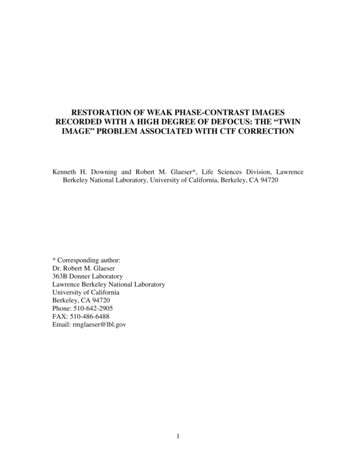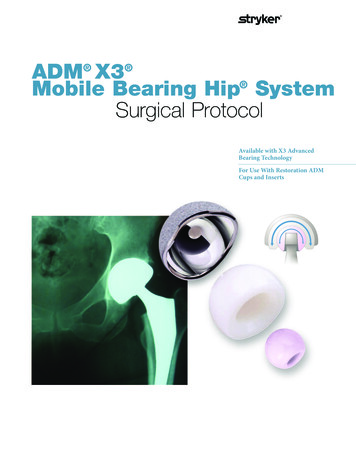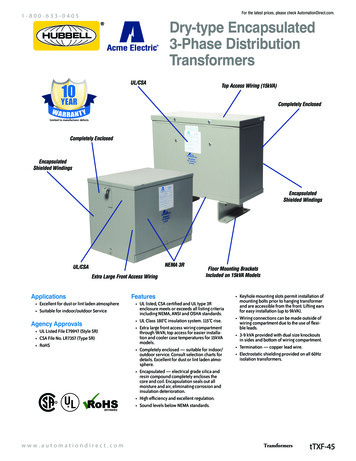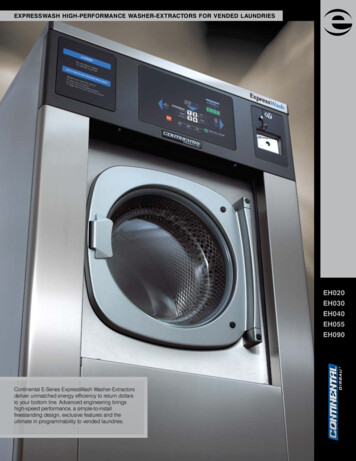
Transcription
RESTORATION OF WEAK PHASE-CONTRAST IMAGESRECORDED WITH A HIGH DEGREE OF DEFOCUS: THE “TWINIMAGE” PROBLEM ASSOCIATED WITH CTF CORRECTIONKenneth H. Downing and Robert M. Glaeser*, Life Sciences Division, LawrenceBerkeley National Laboratory, University of California, Berkeley, CA 94720* Corresponding author:Dr. Robert M. Glaeser363B Donner LaboratoryLawrence Berkeley National LaboratoryUniversity of CaliforniaBerkeley, CA 94720Phone: 510-642-2905FAX: 510-486-6488Email: rmglaeser@lbl.gov1
ABSTRACTRelatively large values of objective-lens defocus must normally be used toproduce detectable levels of image contrast for unstained biological specimens, which aregenerally weak phase objects. As a result, a subsequent restoration operation must beused to correct for oscillations in the contrast transfer function (CTF) at higher resolution.Currently used methods of CTF-correction assume the ideal case in which Friedel matesin the scattered wave have contributed pairs of Fourier components that overlap with oneanother in the image plane. This “ideal” situation may be only poorly satisfied, or notsatisfied at all, as the particle size gets smaller, the defocus value gets larger, and theresolution gets higher. We have therefore investigated whether currently used methods ofCTF correction are also effective in restoring the single-sideband image information thatbecomes displaced (delocalized) by half (or more) the diameter of a particle of finite size.Computer simulations are used to show that restoration either by “phase flipping” or bymultiplying by the CTF recovers only about half of the delocalized information. Theother half of the delocalized information goes into a doubly defocused “twin” image ofthe type produced during optical reconstruction of an in-line hologram. Restoration witha Wiener filter is effective in recovering the delocalized information only when thesignal-to-noise ratio (S/N) is orders of magnitude higher than that which exists in lowdose images of biological specimens, in which case the Wiener filter approaches divisionby the CTF (i.e. the formal inverse). For realistic values of the S/N, however, the “twinimage” problem seen with a Wiener filter is very similar to that seen when either phaseflipping or multiplying by the CTF are used for restoration. The results of thesesimulations suggest that CTF correction is a poor alternative to using a Zernike-type2
phase plate when imaging biological specimens, in which case the images can berecorded in a close-to-focus condition, and delocalization of high-resolution informationis thus minimized.3
INTRODUCTIONUnstained biological specimens are often well approximated as being weak phaseobjects. As Zernike emphasized in his Nobel lecture, images of phase objects show nocontrast in a perfectly corrected microscope [1]. In order to overcome this problem, theobjective lens is normally defocused by an amount that is large enough to producesufficient contrast to see the specimen. As an example, a defocus value of 1 µm or moremight be used in order to see particles with a molecular weight of 1 MDa.Although the low-resolution features of a phase object are made visible byintroducing a substantial amount of defocus, the higher-resolution features then becomebadly corrupted due to oscillations in the contrast transfer function (CTF). This adverseconsequence of using high amounts of defocus can be overcome to a substantial degreeby computational “image restoration”. Applying a computational CTF correction to anout-of-focus image is, in fact, not unlike Gabor’s original concept of optical restoration ofthe object from an in-line hologram – which is nothing other than a highly defocusedimage [2].It is well known that optical reconstruction of an object from an in-line hologramsuffers from a substantial artifact, however, an effect that is referred to as the “twin imageproblem”. As Gabor explained in his Nobel acceptance speech [3], optical reconstructionof an in-line hologram produces two images superimposed on each other, one of which isin sharp focus and the second of which is defocused by twice the amount of that in theoriginal hologram. The issue that is addressed here, therefore, is the extent to whichcomputational CTF correction also suffers from a similar “twin image” problem.4
Our original purpose in simulating CTF correction was to understand how effectivelyit deals with the fact that a portion of the scattered wave produces an interference patternin the region of the image that is adjacent to, but outside the geometric shadow of a smallparticle, for example a multiprotein complex. As is explained below, this delocalizedinformation is not modulated by the usual CTF. Instead, the delocalized information canbe described as a sum of interference fringes, each with a different spatial frequency, thatare shifted in phase by an amount proportional to the product of the defocus and thespatial frequency.We have investigated this question by applying three commonly used restorationtechniques to the Fourier transforms of various simulated images. The results show that“phase flipping” and multiplying by the CTF both restore only about half of the originalsignal, the second half going into a doubly-defocused twin image (background).Although the results obtained by these two methods are similar, phase flipping results ina slightly better restoration of signal than does multiplying by the CTF. In light of thesefirst results, it is not surprising that we also found that the ability of a Wiener filter torestore the object depends upon the value of the parameter that is used to estimate thesignal-to-noise ratio (SNR). When the SNR is high, using a Wiener filter approaches theoperation of dividing by the CTF, which is algebraically guaranteed to produce perfectrestoration (but only in the absence of noise-amplification at the zeros of the CTF). Whenthe SNR is low, however, as it is in low-dose cryo-EM images, use of a Wiener filterapproaches the operation of multiplying by the CTF.One of the advantages of recording images of weak phase objects with a phasecontrast aperture [4-8] is that defocus is no longer required in order to produce adequate5
contrast, and thus no information-delocalization occurs. On the other hand, this advantagewould not be as important as it first sounds, if it were also true that no informationdelocalization remained after the appropriate CTF correction had been applied. Sinceboth numerical simulations and analytical theory show that CTF correction can be onlypartially effective in restoring the initially delocalized information, however, we concludethat CTF correction is a poor alternative to the use of in-focus phase-contrast imaging.SIMULATION METHODSImage simulations were carried out using scripts written in DigitalMicrograph (Gatan,Inc., Pleasanton, CA). For calculation of single-sideband images, the original image wasdefined as a complex array so that the full Fourier transform would be computed and onehalf could then be set to zero. Fourier transforms of the images were modified either bymultiplying by an appropriately defined function or by separating the modulus and phasecomponents and modifying these as appropriate.A modified spoke pattern was generated using the function “sin(n itheta)” inDigitalMicrograph that makes a full-circle pattern with n spokes. The full-circle patternwas then masked to produce a narrow wedge, after which the test pattern was low-passfiltered to smooth the edges of the pattern.A two-dimensional, sinusoidal cross-grating pattern was defined in a 512x512 pixelarray as the product of one-dimensional sine functions that are parallel to the x-axis andthe y-axis, respectively. The strongest Fourier components in this test pattern thereforerun diagonally with respect to the x and y axes. This full pattern was masked with asquare box whose edge-length was equal to 6.5 cycles of the sine functions.6
An image of the 50S (large) subunit of the E.coli ribosome was calculated usingatomic coordinates given in the PDB file 1VOR [9]. A molecular model was generatedusing the “copy from pdb” command in SPIDER [10] to calculate a 3-D density at aresolution of 0.1 nm/pixel. Functions in Bsoft [11] were then used to project the densityand output a file in TIFF format as a 512x512 array.Noise was not included in the simulations shown here. We assume that (1) the signaland the electron shot-noise that are present in experimental image intensities are additive,and (2) these two terms remain additive during the CTF-correction operations that areapplied during data analysis. It is true that CTF-correction of just the intensity patterncorresponding to the electron shot-noise itself will result in a texture whose amplitudespectrum is no longer “white” but whose phases are still random. Even so, this texturewill be uniformly the same within the envelope of a particle and in the area outside theparticle. Since an appropriate level (and texture) of “CTF-corrected” noise can be addedto the results shown here, there is no loss of generality in computing and displaying onlythe effects that delocalization and subsequent restoration have on the signal. The purposeof NOT including noise in the simulations is to avoid confusion between the effects thatare due to delocalization of the signal and those that are added by noise. In practice, thedelocalized signal is largely masked by the noise, but because of the additivity of thesignal and the noise, both the delocalization of signal and its partial restoration will bewell-described by our noise-free simulations.BACKGROUND AND THEORY7
The contrast transfer function (CTF) that is used for image restoration in cryo-EM isgiven, in the simplest case, byCTF ( s ) sin γ ( s ),γ ( s ) 2π [C s λ3 4 z 2s s ],42Equation 1wheres the spatial frequency (resolution),γ(s) the wave aberration associated with spherical aberration and defocus,Cs the coefficient of spherical aberration,λ the electron wavelength, and z the defocus of the objective lens.We have ignored the wave aberration due to spherical aberration in this paper, in order toemphasize solely the effect of defocus. For typical electron microscopes, the waveaberration due to spherical aberration makes a significant contribution to delocalizationfor only the highest-resolution features, for example Fourier components with awavelength shorter than 0.5 nm. The addition of a spherical-aberration term in thesimulations shown here would have had no visible effect, and in any case it would notcontribute new principles to what is learned from the simulations presented here.If the specimen is a weak phase object, then the Fourier transform of the experimentalimage intensity, Iˆexp ( s ) , is related to the Fourier transform of the shielded Coulombpotential of the object, F (s ) , by8
Iˆexp ( s ) δ ( s ) 2 F ( s ) CTF ( s )Equation 2The derivation of equation 2 assumes that the Fourier transform of the object satisfiesFriedel’s law and that the sinusoidal Fourier components of the object are spatiallyunbounded, as they are for a two-dimensional crystal [12]. Under these conditions pairsof sinusoidal “fringes” in the image that are produced by interference of one diffractedbeam with the unscattered beam and by the interference of its Friedel mate with theunscattered beam are shifted in opposite direction. The amount of their respective phaseshifts corresponds to the magnitude of the resolution-dependent phase distortion, γ(s).Depending upon the amount of defocus, these individual pairs of fringes thus vary frombeing in phase with one another to being completely out of phase with one another, andthen back to being in phase but with the reversed contrast. When these two intensityfringes are added, the net result is that the phase origin of the resulting sum is not shiftedbut its amplitude is modulated by an amount that varies between 1 and -1 of what itshould be, i.e. by the value of the CTF that is given in equation 1.CTF correction is normally thought of as an operation that, at the very least, reversesthe sign of those Fourier components that have been transferred with the wrong sign.Since a change in sign is equivalent to a 180 degree phase shift, this sign change is oftenreferred to as “phase flipping”. Depending upon what version of CTF correction is used,the operation may also adjust the magnitude as well as the sign of the amplitude.Multiplication by the CTF, for example, not only corrects the sign of the amplitude butdown-weights the contributions of frequencies where the SNR is especially poor (forexample, close to the zeros in the CTF).9
An even better restoration is provided by the Wiener filter [13], expressed in the formthat is appropriate for deconvolution of the effects causedby the CTF(http://en.wikipedia.org/wiki/Wiener deconvolution):w( s ) CTF ( s )[CTF ( s )]2 1 / SNR( s )Equation 3wherew(s) the weighting function that is applied as a filter during image restoration, andSNR(s) the “signal-to-noise ratio” at a given spatial frequency, s. Note that SNR isdefined here as the mean power spectral density of the input signal divided by the meanpower spectral density of the noise.Although the Wiener filter provides a restored image that has the smallest possiblemean square error relative to the true structure, it is often not used in practice because nomethod has been established for determining the experimentally correct value for SNR(s).Even when an estimate of the Wiener filter is used, one often assumes that SNR(s) isconstant, in effect assuming that the power spectral density of the input signal is constant.This is an approximation that is never satisfied for images of biological macromolecules,however.When the Fourier components of an object are confined to a small area, as they arefor small crystalline patches and for single particles, a given set of fringes is shifted as asmall, defined patch. The size and shape of the patch corresponds to the dark-field imagethat would be formed by the diffracted beam if the unscattered beam were blocked by theobjective aperture [14]. The center of the patch is displaced from the center of the particle10
by an amount equal to the value of (gradient of γ(s) divided by 2π) at the spatialfrequency of the fringes, s.”As theory [14] requires, sinusoidal fringes – which should lie at the positions ofcrystalline lattice planes, for example – are thereby shifted beyond the edge of a particle.The amount of displacement that can occur before the fringes are no longer visibleoutside the particle is determined by the spatial coherence of the incident electron beam.Similarly, depending upon the amount by which the patches are shifted (i.e., dependingupon the amount of defocus), the area within which the fringes overlap with one anotheris only a fraction of the patch size. In particular, the area of overlap falls to zero when theamount of shift is one half of the particle size. In the region (if any) where the patchesstill overlap with one another, the contrast transfer is still described by the usual CTF thatis written in equation 1. Outside the region of overlap, however, the fringes behave as“single sideband images” [12]. In this case the amplitude of the fringes is no longermodulated by sin(γ) ; instead, their phases are shifted by γ(s).The EM community is generally aware that one must apply CTF correction to an areasurrounding a particle and not just the particle itself (i.e. one must not mask the particletoo tightly). It is also clear that dividing the Fourier transform of a defocused image bythe CTF is the mathematical inverse of the multiplication by the CTF that is shown inequation 2. Although dividing by the CTF thus restores the object perfectly for noisefree images, the images obtained in cryo-EM are so noisy that dividing by the CTF is nota viable operation. What has not been discussed in the EM literature, however, is theextent to which alternative methods of CTF correction are successful in restoring the11
portion of the delocalized signal that is transferred as single-sideband fringes (rather thanas CTF-modulated fringes).RESULTSThe signal-delocalization effect is first illustrated with the help of two relativelysimple test-objects, a spoke-type resolution-test pattern, and a square cross-gratingpattern. A simulated image of the large ribosomal subunit is then used to show therelevance of delocalization in the context of cryo-EM images of macromolecularcomplexes.The spoke pattern shown in Figure 1A is informative because it contains a ramp ofspatial frequencies that are separated in space along the length of the pattern. This testpattern thus makes it possible to easily visualize the frequency dependence of thedelocalization effect. Figure 1B shows the image that would be obtained for this test“object” with a defocus of 2 µm, if we assume that the width of the entire panel is 30 nm.Note that the zeros of the CTF cause zones of little or no contrast at different horizontalpositions in the image of this test pattern, while the sign reversals of the CTF cause zonesof inverted contrast. Both of these effects are confined to the (vertically defined) middleportion of the defocused image, however. The top and bottom portions of the spokepattern retain full contrast even where the CTF is zero because the fringes from a givenFourier component no longer overlap with those from its Friedel mate at the edge of a“particle”, due to delocalization. In addition, delocalization causes the appearance that the12
spokes curve away from the edge of the original test pattern as the spatial frequencyincreases (i.e. as one moves to the right along the test pattern).Due to the linearity of image formation for weakly scattering objects, the image inFigure 1B can be described mathematically as the sum of the two single-sideband imagesthat are shown in Figures 1C and 1D. The contrast in single-sideband images is notmodulated by zeros in the CTF, and this fact is reflected in these two respectivesimulations. The phases of Fourier components of the object are, however, shifted by thewave aberration in single-sideband images [12], as we have already said above. This shiftin phase accounts for the bending (vertical shifting) of the images of the spokes, whichonly becomes conspicuous in the far-right portion of the test pattern. The “beating” orinterference of shifted fringes that occurs when the images in Figures 1C and 1D aresuperimposed is what accounts for the zones of no contrast and the zones of invertedcontrast that are shown in Figure 1B. Constructive and destructive interference betweenthe two single-sideband images can occur only over the vertical positions where theshifted Fourier components overlap with one another, of course. As a result, the usuallyinvoked effects of the CTF (contrast modulation and phase flipping) apply to aprogressively smaller fraction of the signal as the resolution increases, and they no longerapply at all when the amount of delocalization is greater than half the size of the object.The cross-grating test-pattern shown in Figure 2A illustrates the delocalization effectin a complimentary way. For the sake of argument, this object might be considered to bea square particle that is 8.5 nm on edge. The structure within this “particle” consists ofthe product of two Fourier components that run perpendicular to one another, in13
directions that are parallel to the edges of the square. In this example, the two sinusoidalcomponents both have a period of 1.3 nm.Figure 2B shows a simulation of the image that this test object would produce at adefocus of 3 µm. This value of defocus was chosen in order to shift the patch of each setof fringes by half the edge-length.Figures 2C and 2D show the results produced when two commonly used methods ofCTF correction are applied to the defocused image in figure 2B. These resultsdemonstrate that the original object is recovered remarkably well by CTF correction. Thecontrast restoration is, in fact, somewhat more complete when CTF correction is done byphase flipping rather than by multiplying by the CTF. A quantitative comparison betweenthe contrast in the original object and that obtained after CTF correction demonstratesthat 50 % of the delocalized signal is restored by multiplying by the CTF. and 65 % ofthe delocalized signal is restored by phase flipping. The simulations also show that theremainder of the signal is delocalized once again as a result of both of these procedures.In other words, the twin-image problem observed for optical reconstruction of an in-linehologram also occurs when either phase flipping or multiplying by the CTF is used as therestoration filterIn order to continue this investigation with a test object that is similar to an actualcryo-EM image, we next calculated a noise-free, highly defocused image of the largesubunit from the E. coli ribosome. Figure 3A shows the image obtained for a defocus of 2µm and an accelerating voltage of 300 kV. The ribosomal test object, unlike the simplertest objects used in Figures 1 and 2, now consists of a continuous spectrum of spatiallysuperimposed Fourier components. The delocalized information therefore consists of a14
continuum of overlapping patches, each displaced by an amount that is determined by thegradient of γ(s) at that particular spatial frequency.Figure 3B shows the nearly perfect restoration that is achieved with a Wiener filterwhen the value of the SNR is assumed to be 900. The simulations themselves are noisefree in all cases, as we have stated previously. The stipulation of a given value of theSNR is used only to see what the effect would be on the signal-component of an image,due to a given value of SNR that is used in the Wiener filter. The restoration producedwith SNR 900 is shown because the Wiener filter in this case is almost equivalent todividing by the CTF, which in turn is guaranteed to give perfect recovery of the originalobject from a noise-free image. Nevertheless, even for data with a SNR as high as 900,low-frequency artifacts still remain in the Wiener-filtered restoration, due to theweakness of the filtered amplitudes at low frequencies.A more realistic simulation of the recovery of delocalized information that can beexpected is provided by setting the SNR equal to 0.09 (Figure 3C). In this case the CTFcorrection lies somewhere between that provided by phase flipping and by multiplying bythe CTF, as we show in connection with Figure 4, below. Not at all unexpectedly, basedon the simulations shown with the simpler example in Figure 2, the twin-image is onceagain present when this more realistic Wiener filter is used for CTF correction. In fact,the twin-image artifact persists even when the SNR parameter in the Wiener filter is setto the unrealistically optimistic value of 9 (Figure 3D).Additional understanding of how various CTF corrections compare to one another isprovided by the curves shown in Figure 4, which shows the CTF itself as well as threeexamples of the product of the CTF and different versions of the Wiener filter. The black15
curve is the CTF itself (calculated for a defocus of 2 µm and an electron energy of 300keV), which contains sign reversals between successive zeros. The weighting of CTFcorrected amplitudes (i.e. the resultant “transfer function” for restoration) that is obtainedby phase flipping can be envisioned by converting the negative lobes of the CTF curve toidentical, positive lobes. Similarly, the weighting of amplitudes that is obtained bymultiplying by the CTF can be pictured as a version of the phase-flipped CTF in whichthe “bell-shaped peaks” are simply more narrow. The blue curve in Figure 4 shows theweighting of amplitudes that would be obtained with a Wiener filter for which SNR 0.09. Such a Wiener filter is similar to multiplying by the CTF, as we stated previously.The green curve shows the weighting obtained with a Wiener filter when the SNR is setto be 9, as it was for figure 3D. Finally, the red curve shows the near-perfect restorationof amplitudes (except at low frequencies and very close to the zeros in the CTF) that isachieved with a Wiener filter for which SNR 900.DISCUSSIONHighly defocused images of a weak phase object can be described from threedifferent, but ultimately equivalent perspectives. From one point of view, one can say thatthe wave function producing such images is a Fresnel diffraction pattern that is producedby propagation of the exit wave (i.e. the wave function transmitted through the object).The intensity distribution of such a Fresnel diffraction pattern is, in turn (for a weaklyscattering object), an in-line hologram of exactly the type that Gabor hoped to use toovercome the limitation associated with the spherical aberration of the objective lens [2].From another point of view, one can describe these images by the mathematics of linear16
systems [15], in which case the image wave function is obtained by convoluting the exitwave with the coherent point-spread function of the optical system. From a thirdperspective, the images can be represented as a sum (integral) of terms contributed byeach diffracted beams, i.e. by each Fourier component of the exit wave [14]. This latterperspective, although mathematically cumbersome and requiring the use of a localTaylor-series approximation to provide physical insight, explains very clearly whyinformation at different levels of resolution is delocalized (shifted) by different amounts.The mathematical description of image formation that is based on linear-systemstheory provides the simplest explanation for why the delocalized information is perfectlyrestored when the Fourier transform of an image of a weakly scattering object is dividedby the contrast transfer function (CTF) [15]. In practice, however, division by the CTF isnot possible at the zeros of the CTF. For noisy images of the type that can be recorded bycryo-EM of radiation-sensitive specimens, division by the CTF may even cause severenoise-amplification at most spatial frequencies, i.e. not just those close to the zeros of theCTF.Data restoration that is achieved by multiplying by the CTF, or even by the simpleroperation of phase flipping, gives a result that does not differ greatly from using a Wienerfilter when the SNR is low. In fact, phase flipping and CTF multiplication produce aremarkable recovery of the delocalized information, as can be seen most easily with thesimplified test object used in Figure 2. Although phase flipping restores a slightly higherfraction of the delocalized signal, multiplication by the CTF is to be recommended as aneasy way to give reduced weight to Fourier components with a poor SNR. The use of a17
Wiener filter for CTF correction, on the other hand, represents the optimal approach fordata recovery at any level of noise.The simulations presented here demonstrate that full recovery of delocalizedinformation is generally not possible when CTF correction is applied to a defocusedimage. Instead, approximately half of the signal, which is referred to as the “twin image”in holography, is superimposed on the restored image, effectively being defocused bytwice the original amount. This added background is generally not recognizable as beingstructurally related to the object (i.e. to the restored image), and the twin image thus actseffectively as unwanted noise in the reconstruction.Yonekura and Toyoshima have investigated the effect that applying solvent flatteningafter CTF correction, followed by merging of data from images recorded at differentdefocus values, has on mitigating the “twin-image” noise that intrudes into the area of agiven particle from closely adjacent, foreign particles in the specimen. These foreignparticles were modeled as rectangles of different width and height, and they wereregarded as a form of noise [16]. While solvent flattening clearly is effective insmoothing the background, and averaging is effective in “canceling” the intrusion oftwin-image noise that has entered into the volume of a particle, neither procedure is ableto capture and return the half of the signal, derived from the particle itself, that is doublydelocalized outside the envelope of the particle during CTF correction.The simulations presented here show that partial restoration of delocalizedinformation occurs to a similar extent when CTF correction is carried out (1) with aWiener filter (assuming a realistic value of the signal-to-noise ratio), (2) by multiplyingwith the CTF, or (3) by phase flipping. This empirical result is not intuitively obvious,18
and in fact it is not immediately obvious why phase flipping or multiplying by the CTFshould restore any of the delocalized information. That these operations nevertheless doshift some of the delocalized information back to the area of the particle can beunderstood in terms of the mathematical approximation used by Budinger and Glaeser[14] to explain, on the basis of Fourier optics, why individual Fourier components of anobject are shifted out of the area of a particle to begin with.Briefly, the Fourier transform of a small object that contains a single, boundedFourier component is the convolution of a Dirac delta function – at the spatial frequencyof that Fourier component – and the Fourier transform of a function that describes theboundary and the position of the particle. According to the Fourier shift theorem,application of a linear phase ramp to such a Fourier transform causes the bounded Fouriercomponent to shift away from the original position of the particle. Defocusing an imageinvolves application of a quadratic phase shift to the Fourier transform of the object, butlocally (e.g. at the position of the Dirac delta function) this wave aberration can beexpanded in a Taylor series, the second term of which is a linear phase ramp. This linearterm thus explains t
DigitalMicrograph that makes a full-circle pattern with n spokes. The full-circle pattern was then masked to produce a narrow wedge, after which the test pattern was low-pass filtered to smooth the edges of the pattern. A two-dimensional, sinusoidal cross-grating pattern was defined in a 512x512 pixel










